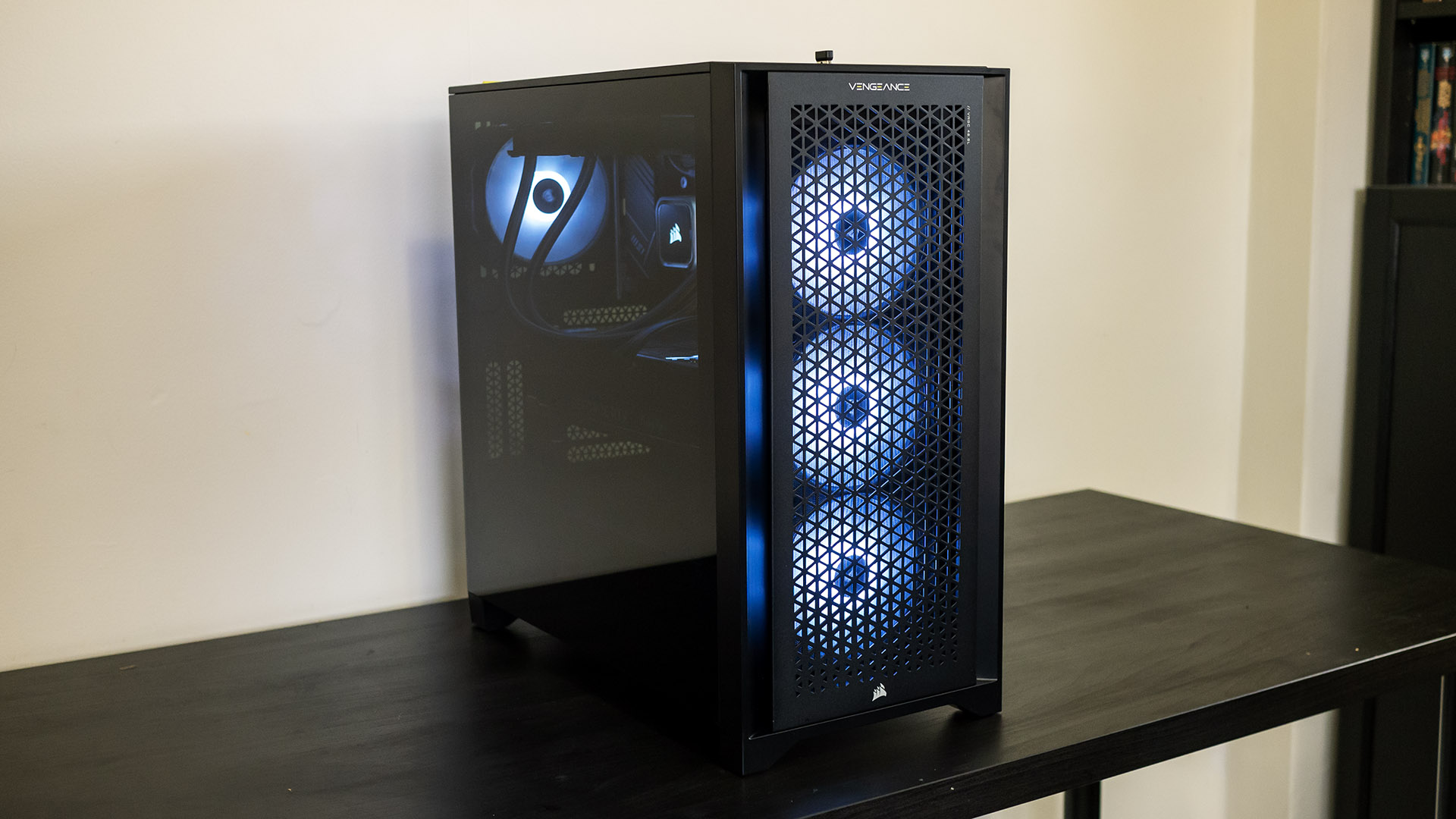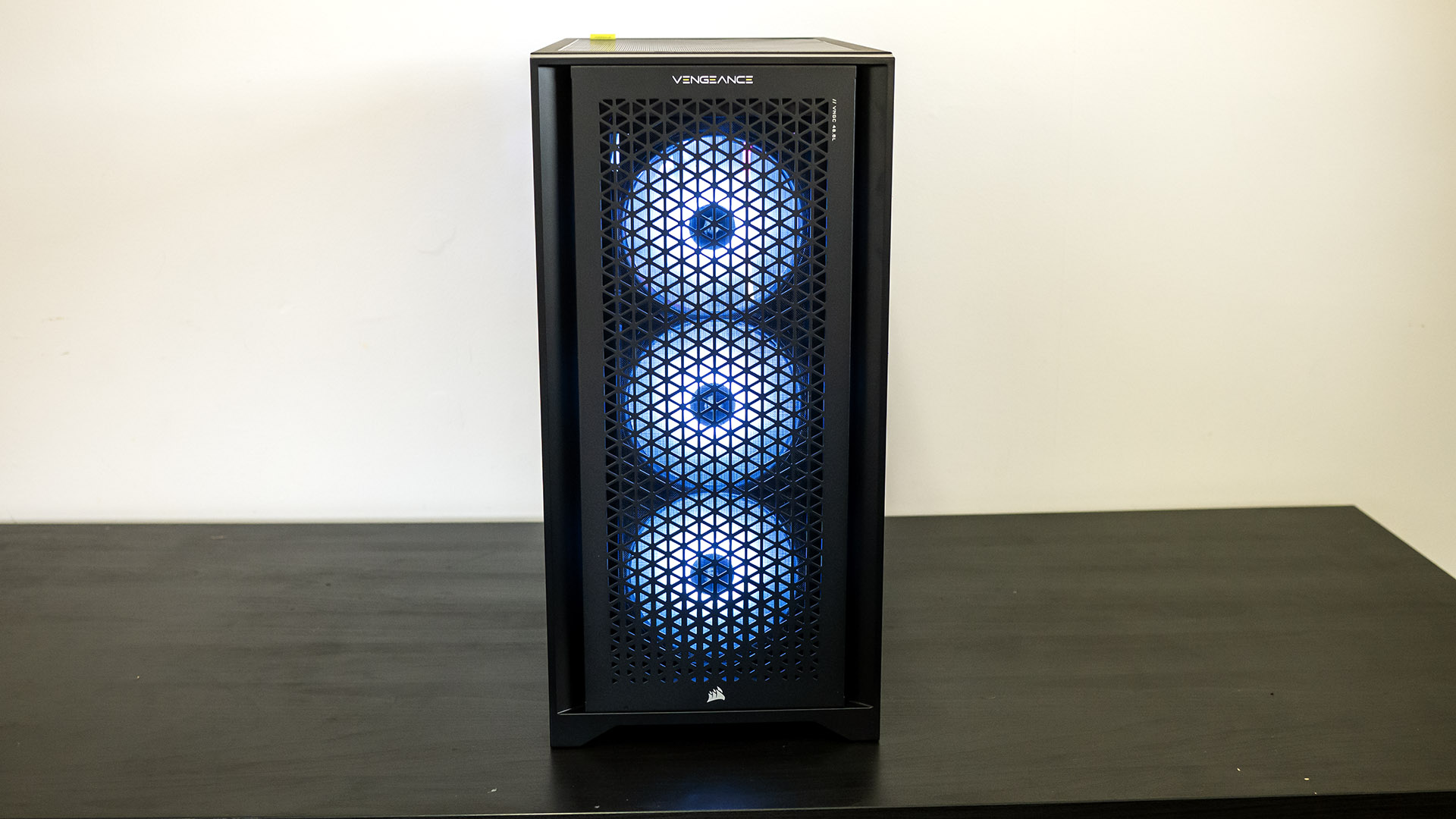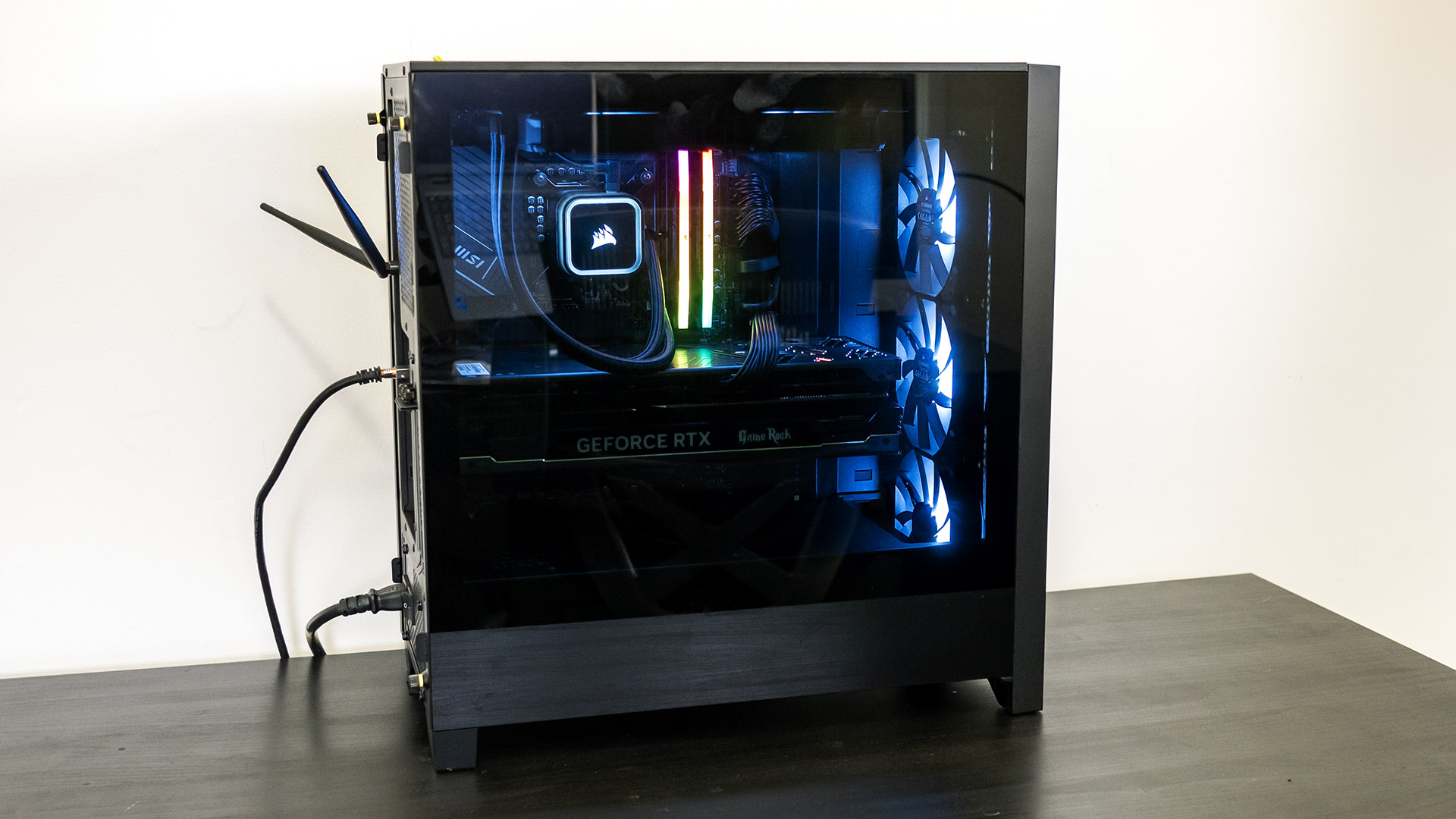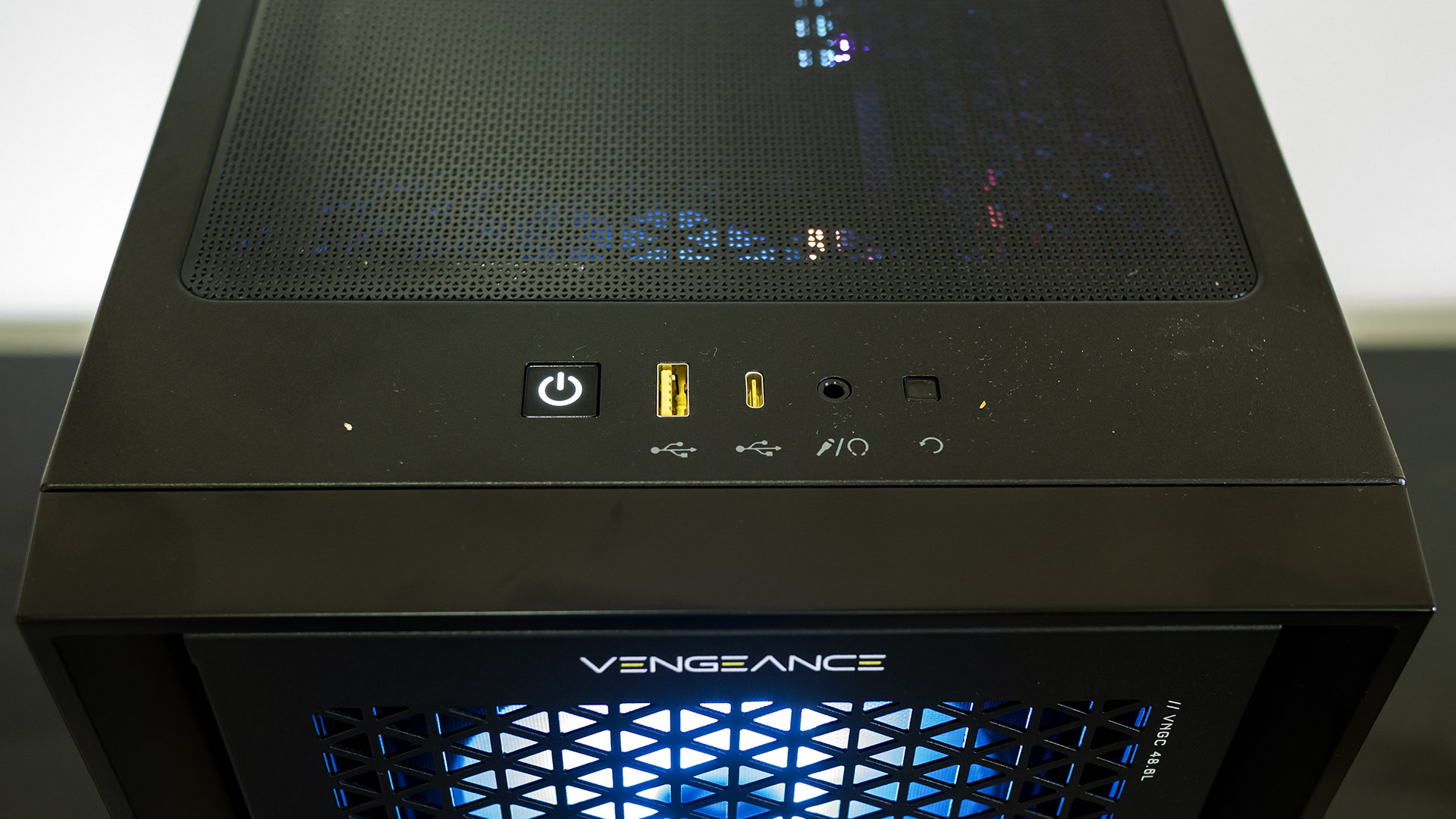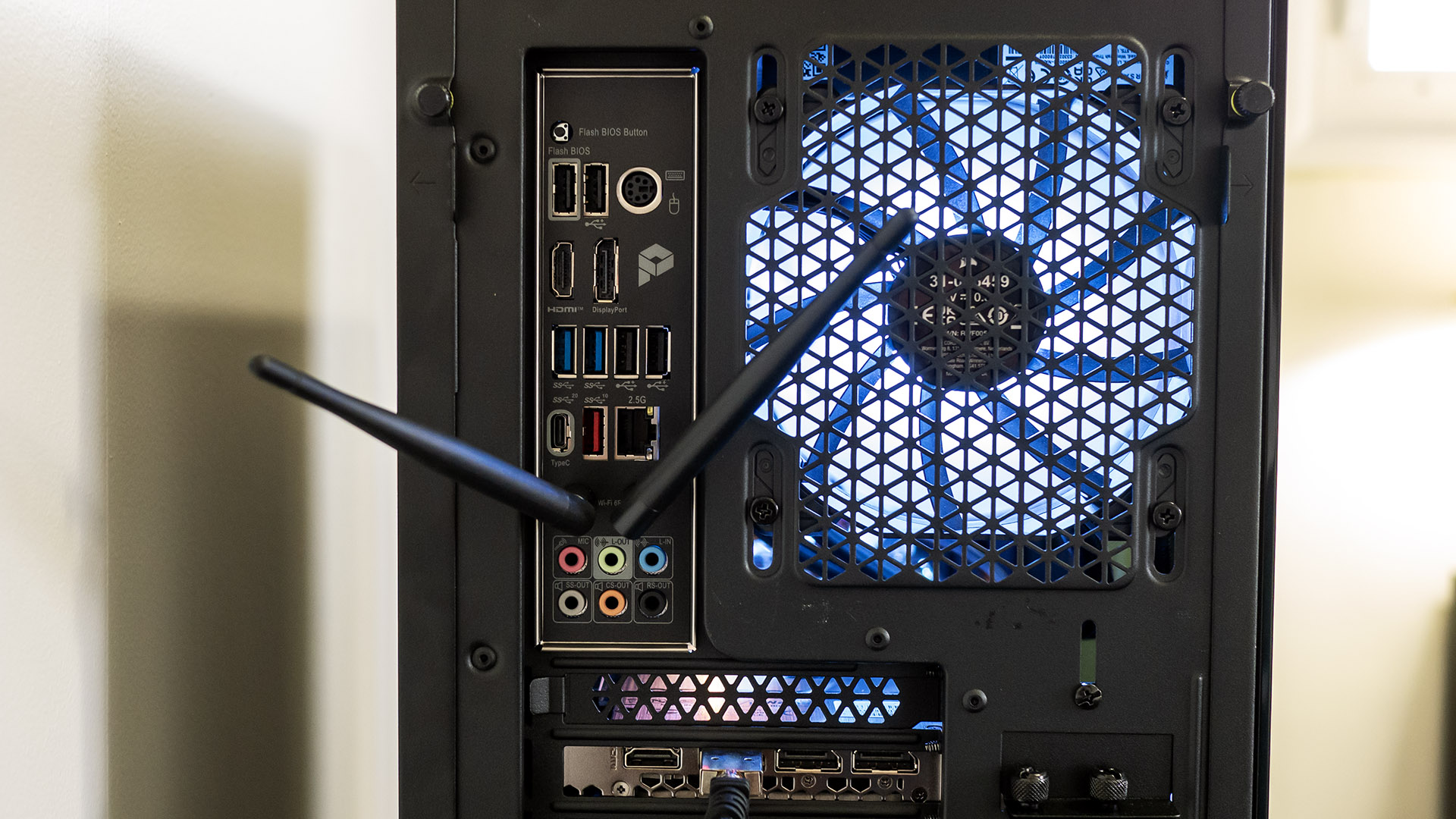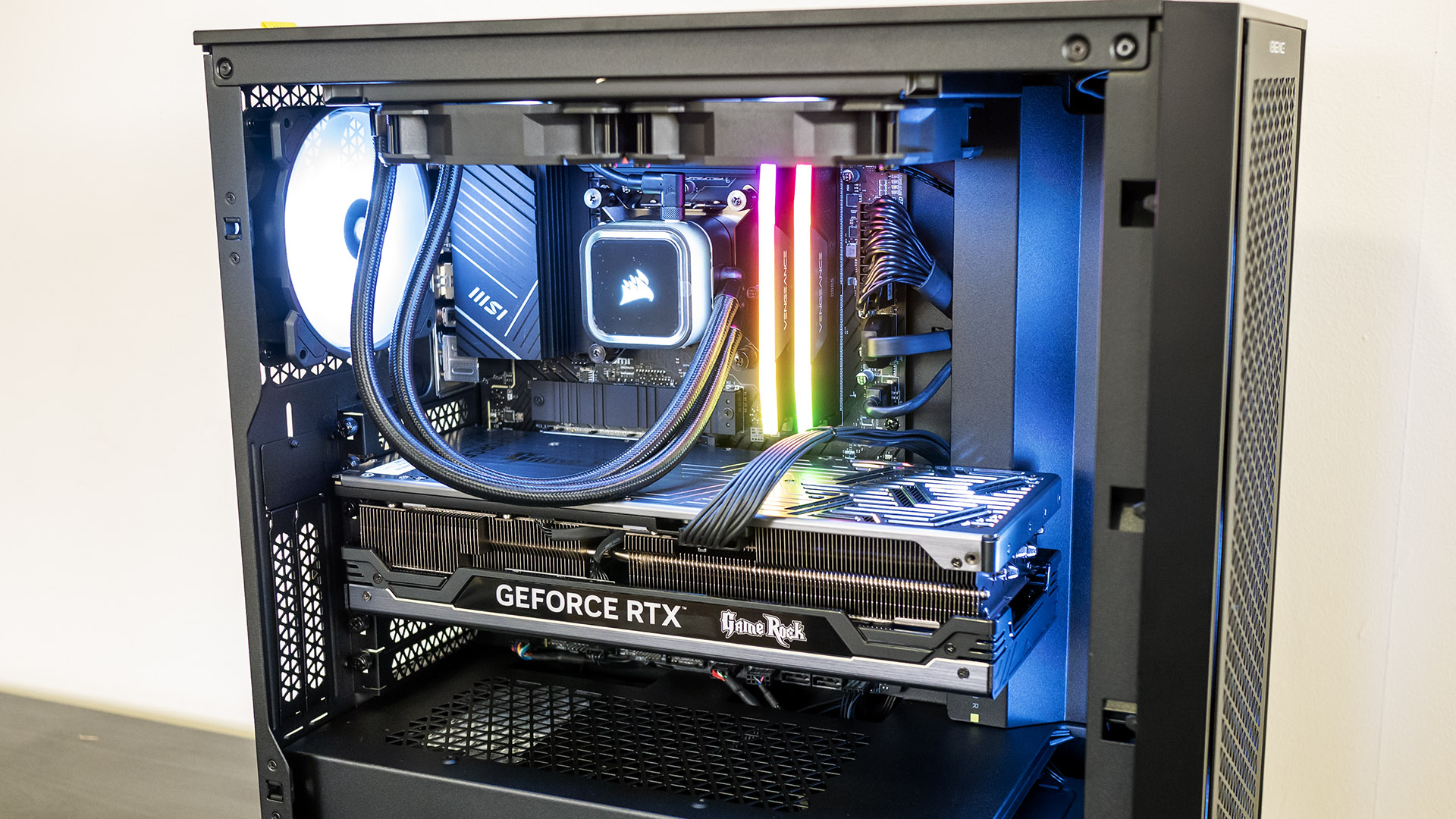Tom's Hardware Verdict
Corsair’s Vengeance i7500 is exceptionally fast and looks right out of the aftermarket. There’s no doubt it’s a pretty penny, but it’s no more than the competition and comes with a longer warranty.
Pros
- +
Exceptional performance
- +
Quiet operation
- +
Top-notch build quality
- +
Two-year warranty
Cons
- -
Expensive with RTX 4090
- -
No RGB lighting on RTX 4090 as tested
Why you can trust Tom's Hardware
Corsair’s Vengeance i7500 ($3,799.99 as tested) is a preconfigured gaming desktop that looks like it was built by an aftermarket enthusiast. The components that make up this PC can be purchased aftermarket, but Corsair puts them together so it feels like you built it on your own.
Equipped with an Intel Core i9-14900K and an Nvidia GeForce RTX 4090 in our review unit, the Vengeance i7500 easily proved one of the best gaming PCs. It earns high marks for just about everything, especially its standard warranty, which is longer than what most prebuilts come with.
Corsair Vengeance i7500 Specifications
| CPU | Intel Core i9-14900K (8 Performance and 16 Efficient cores, 6.0 GHz Turbo) |
| Motherboard | MSI PRO Z790-P WiFi |
| Memory | 64GB DDR5-6000 (2x 32GB) |
| Graphics | Nvidia GeForce RTX 4090 (Palit GameRock OmniBlack) (24GB GDDR6X, 2,520 MHz boost clock) |
| Storage | 2TB PCI Express 4.0 SSD |
| Networking | 2.5 Gbps Ethernet, Wi-Fi 6E, Bluetooth 5.3 |
| Front Ports | 1x USB 3.2 Gen 1 Type-A, 1x USB 3.2 Gen 2 Type-C, 3.5 mm headphone/microphone |
| Rear Ports | 1x PS/2, 4x USB 2.0, 1x DisplayPort, 1x HDMI, 1x 2.5 Gbps Ethernet, 2x USB 3.2 Gen 1 Type-A, 1x USB 3.2 Gen 2 Type-A, 1x USB 3.2 Gen 2x2 Type-C, 6x audio jacks |
| Power Supply | Corsair RM1000e 1,000-watt ATX 80 Plus Gold, Fully Modular |
| Cooling | Corsair iCue H100i RGB Elite (240mm) |
| Operating System | Windows 11 Pro |
| Dimensions (WxDxH) | 9.1 x 17.8 x 18.3 inches (230 x 453 x 466 mm) |
| Price as Configured | $3,799.99 |
Design of the Corsair Vengeance i7500
Corsair builds its Vengeance gaming desktops from as many of its own components as possible, giving this desktop an aftermarket vibe that can’t be matched by big-box mainstream towers, some of which use proprietary parts. The build starts with Corsair’s excellent Vengeance 4000D mid-tower case decked out with RGB fans.
Three 120 mm fans behind the grated front panel and another fan at the rear are controllable in the included Corsair iCue app for all kinds of effects, from rainbow wave to color shifting and pulsing. The app’s endless controls let you create effects and sync them with other iCue devices.
The two 120mm fans on the Corsair iCue H100i RGB Elite 240mm CPU cooler are also highly visible and shine out the top grate. The front, top, and bottom of this tower all have removable and washable dust filters for simple maintenance, a simple detail that many desktops neglect.
Tinted side glass shows off the Vengeance i7500’s interior. The RGB components emit an obvious glow, namely the CPU waterblock and two sticks of Corsair Vengeance RGB RAM. There are no dedicated interior lighting strips, which I prefer since it keeps the interior darker and allows the RGB components to stand out.
On the RGB topic, I initially thought the RTX 4090 in our review model wasn’t working since it didn't light up at all, but that’s because the Palit-brand GameRock OmniBlack model seen here is indeed devoid of RGB lighting. I’m usually not one to ask for more RGB lighting, but if I spent this kind of coin in a GPU, I’d want the option for it to light it up a bit. Corsair doesn’t state the exact GPU model, so it’s quite possible this tower could ship with a different GPU that does have RGB lighting to some customers.
Get Tom's Hardware's best news and in-depth reviews, straight to your inbox.
The Vengeance i7500 is girthy for a mid-tower, at 9.1 x 17.8 x 18.3 inches (WDH). The Lenovo Legion Tower 7i Gen 8 is slightly skinner (8.31 x 18.27 x 19.37 inches), the MSI Infinite RS 13th is much larger (10.12 x 23.03 x 21.14 inches), and the Alienware Aurora R16 is smaller (7.76 x 18.05 x 16.5 inches), but it uses some proprietary parts.
Ports and Upgradeability on the Corsair Vengeance i7500
Naturally, a big desktop like this Corsair isn’t lacking for ports. The selection starts on the front with one USB 3.2 Gen 1 Type-A, one USB 3.2 Gen 2 Type-C, and a 3.5 mm headphone/microphone jack. The power and reset buttons are also here.
The MSI PRO Z790-P WiFi motherboard has many USB ports (four 2.0, two 3.2 Gen 1 Type-A, one 3.2 Gen 2 Type-A, and one 3.2 Gen 2x2 Type-C), legacy PS/2, 2.5 Gbps Ethernet, six audio jacks, and HDMI and DisplayPort video outputs. The antennas are for the built-in Intel AX211 wireless card that supports Wi-Fi 6E and Bluetooth 5.3. The GeForce RTX 4090 offers one HDMI and three DisplayPort video outputs.
The side panels come off after loosening retainer-style thumbscrews. The main compartment has ample working room and simple access to most components.
The MSI motherboard has four DDR5 DIMM slots and four M.2 slots. The one M.2 slot populated in our unit is just below the CPU waterblock and properly covered by a heatsink. Corsair did a concise job routing cables, and the RTX 4090 is powered with the modern 16-pin 12VHPWR cable directly from the PSU.
Additional storage expansion requires accessing the other side of the tower, where you’ll find two 2.5-inch bays behind the motherboard tray and two 3.5-inch bays in front of the power supply. The latter is a fully modular Corsair RM1000e supplying up to 1,000 watts. The cables here are also neatly bundled.
Gaming and Graphics on the Corsair Vengeance i7500
We’re testing the Vengeance i7500 with an Intel Core i9-14900K processor, a Palit GeForce RTX 4090 GameRock OmniBlack graphics card, and 64GB of DDR5-6000 dual-channel RAM. This is an exceptional configuration and is about as high-end as gaming desktops get in late 2023.
My go-to game for high-end gaming PCs is Cyberpunk 2077; I saw between 70 and 85 fps at 4K with the Ray Tracing Ultra preset and DLSS enabled, and nearly double that (between 145 to 160 fps) when I enabled DLSS Super Resolution (auto preset). The action was always smooth even in intense combat with lots of explosions. This game really shows off what the RTX 4090 can do.
Our benchmark comparison desktops start with the Alienware Aurora R16 featuring a Core i9-14900K and an RTX 4090 like our Corsair. The other two, the MSI Infinite RS 13th with an RTX 4090 and the Lenovo Legion Tower 7i Gen 8 with an RTX 4080, use a Core i9-13900K, which has a slightly lower boost clock than the Core i9-14900K (5.8 GHz versus 6.0 GHz) but otherwise shares the same core and thread count.
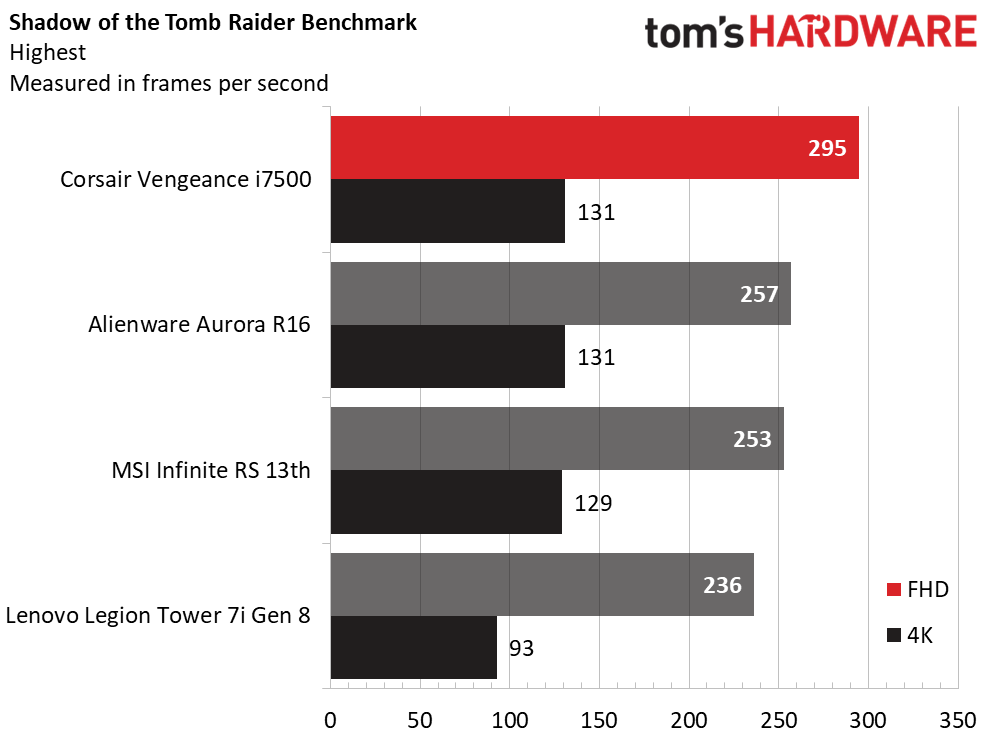

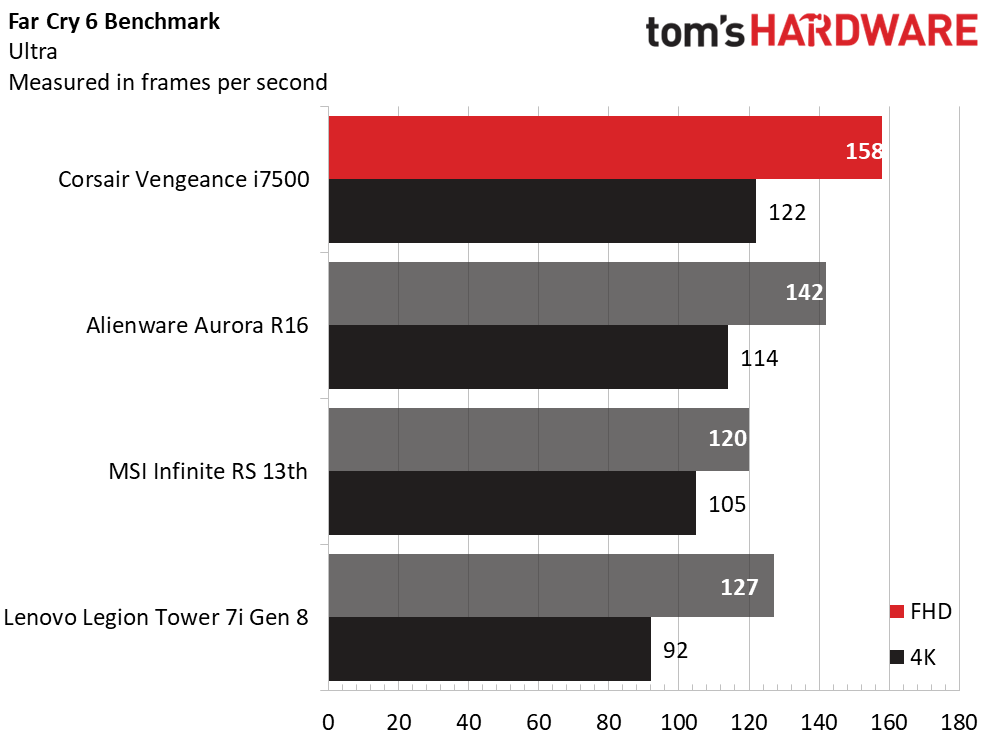
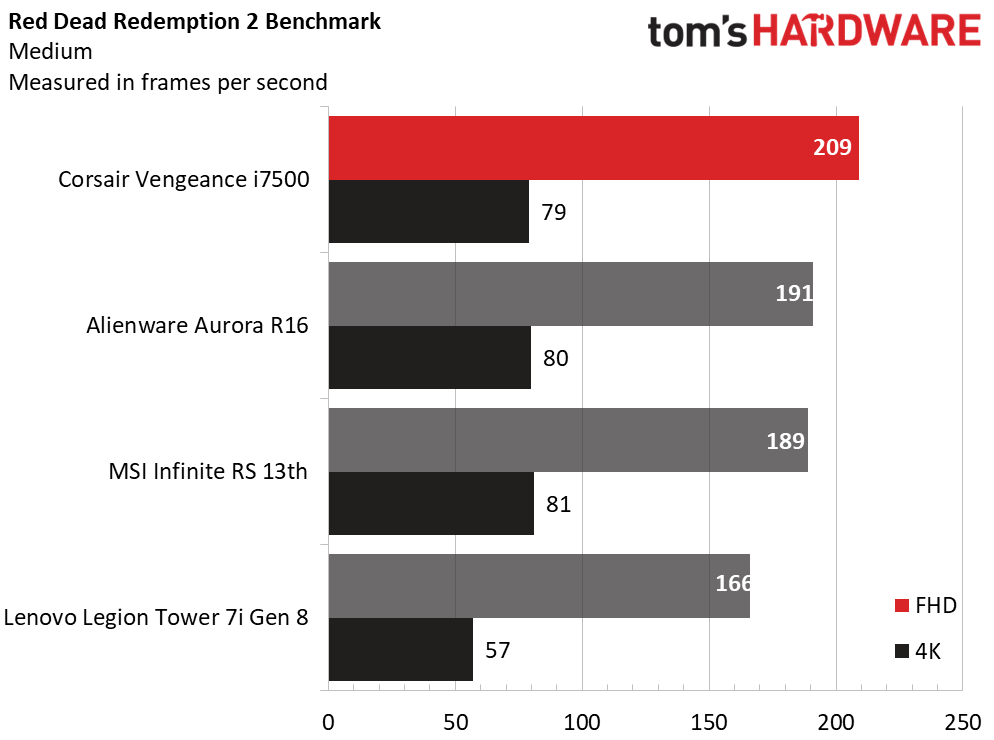

The Vengeance i7500 impressed with chart-topping numbers in Shadow of the Tomb Raider (Highest detail preset), hitting 295 fps at 1080p and 131 fps at 4K. The Alienware and MSI matched it in 4K with 131 fps and 129 fps, respectively, which is not surprising since that resolution isn’t CPU-limited and they also use an RTX 4090. The Legion’s RTX 4080 wasn’t close at 4K (93 fps), but that was a given.
The 1080p scoreboard was a dead heat for these towers in Grand Theft Auto V (Very High) at 1080p, though the Vengeance i7500 again took top honors at 4K with 86 fps; the Alienware and MSI were very close with respective scores of 85 and 82 fps while the Legion predictably picked up the rear with 57 fps.
Far Cry 6 (Ultra) was a clear win for the Vengeance i7500, with 158 fps at 1080p to the Alienware’s next-best 142 fps and 122 fps at 4K to the Alienware’s 114 fps. The MSI fell behind here (120 fps at 1080p and 105 fps at 4K).
The Vengeance i7500 also scored well in Red Dead Redemption 2 (Medium); its 209 fps at 1080p was the highest score, and the 79 fps it produced at 4K was within a frame or two of the Alienware (80 fps) and MSI (81 fps). The Legion’s RTX 4080 sees a much sharper fps drop from 1080p to 4K, which is no surprise.
The Vengeance i7500 topped our charts one last time in Borderlands 3 (using the game’s “Badass” settings preset), running away with the 1080p numbers (287 fps to the next-best Alienware’s 261 fps) and squeaking ahead at 4K (131 fps versus the Alienware’s 130 fps and the MSI’s 129 fps).
The RTX 4090 is clearly well-paired with the Core i9-14900K, though this setup is beyond overkill for anything but 4K gaming. (See our notes on other Vengeance i7500 configurations later in this review.)
We stress test gaming desktops by running the Metro Exodus benchmark 15 consecutive times on RTX settings to simulate half an hour of gaming. During the test, the Vengeance i7500’s Core i9-14900K averaged 5.6 GHz on its P-cores and 4.3 GHz on its E-cores. The average CPU package temperature was 48.7 degrees Celsius. The GeForce RTX 4090’s core clock averaged 2,622 MHz and its average temperature was 49 C.
I noticed little fan noise from the Vengeance i7500 throughout our testing. It proved hard to hear even in a quiet room at idle. The fans increased in RPM while gaming, but not to a degree that interrupted me from using open headphones a few feet away.
Productivity Performance on the Corsair Vengeance i7500
The Vengeance i7500 we’re reviewing has a Core i9-14900K processor, 64GB of DDR5-6000 dual-channel RAM, and a 2TB PCI Express 4.0 SSD. Even the most demanding tasks shouldn’t phase this desktop; it’s a multitasker’s dream with so much memory.
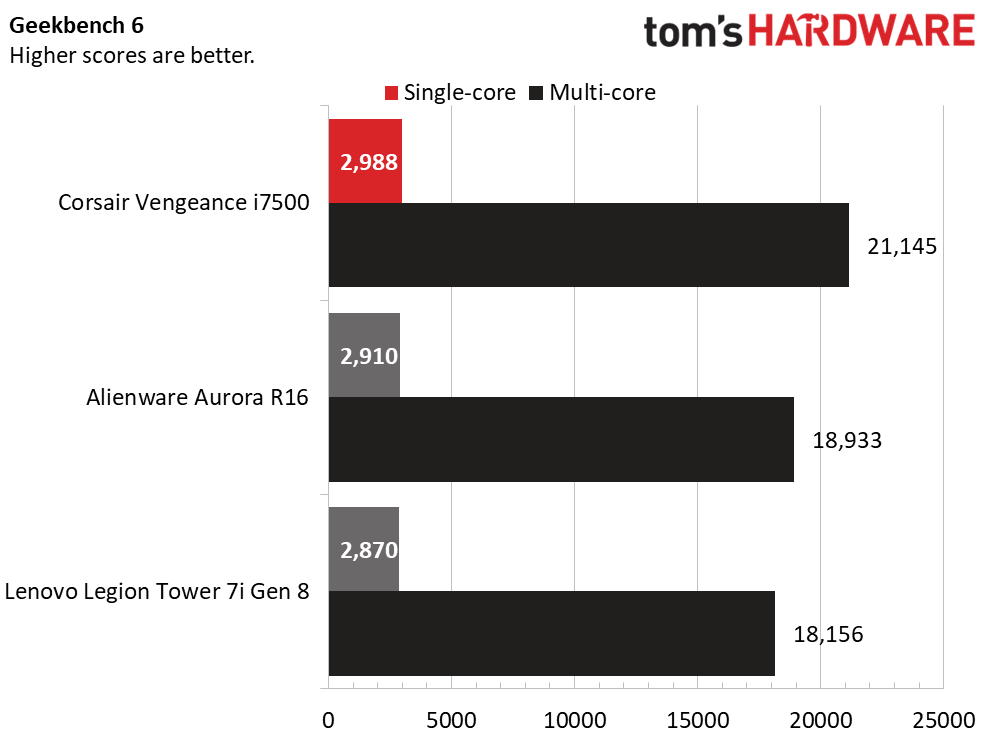
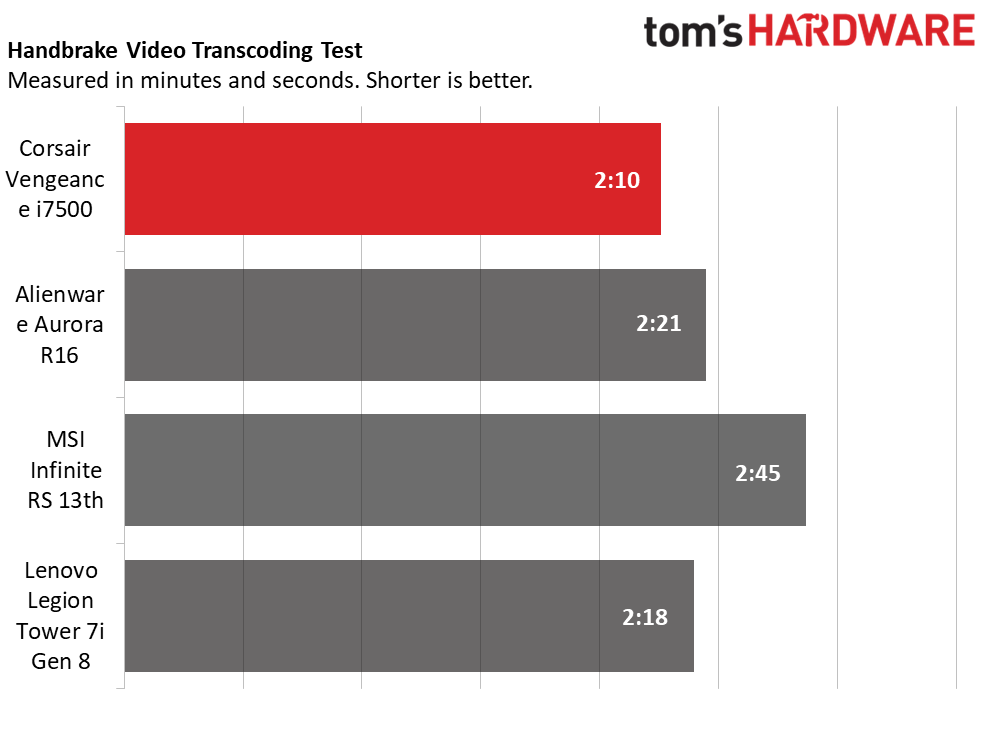
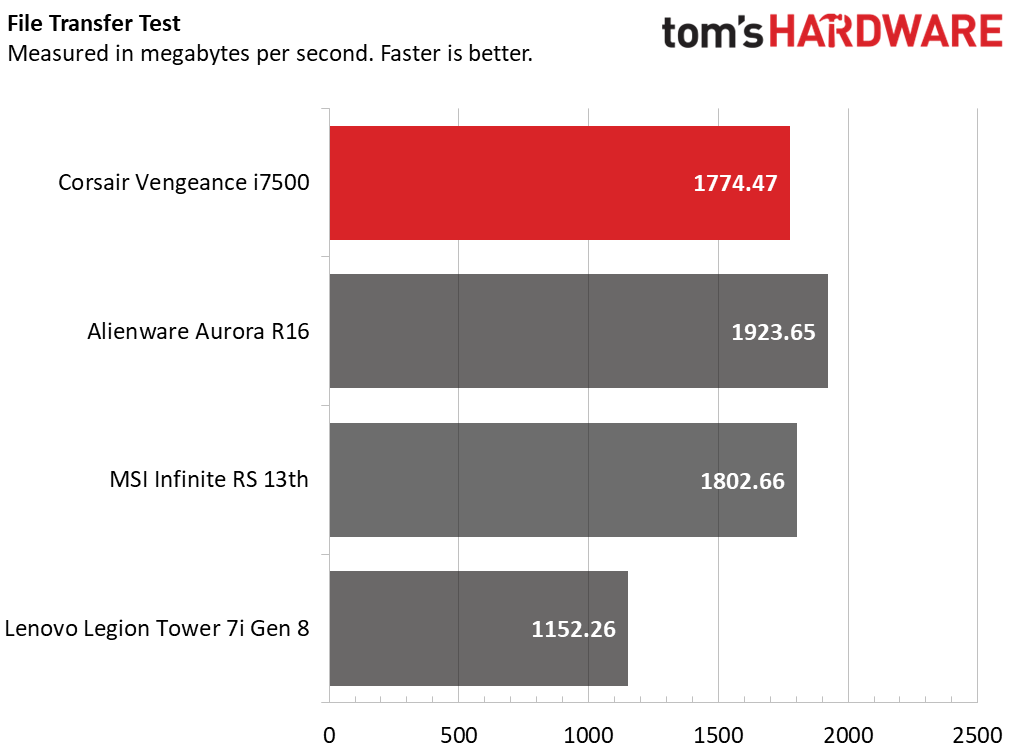
The Core i9-14900K brought the Vengeance i7500 to the top of the charts in the cross-platform Geekbench 6 CPU test, with 2,988 points in single-core and 21,145 points in multi-core. The Alienware was close in single-core (2,910 points) but couldn’t keep up in multi-core (18,933 points). The Legion wasn’t too far back from the Alienware (2,870 in single-core and 18,156 in multi-core).
The Handbrake video transcoding test told a similar story, where the Vengeance i7500 finished in just 2 minutes and 10 seconds. The Legion was very close (2:18), the Alienware slipped into third (2:21), and the MSI brought up the rear (2:45).
Last, the Vengeance i7500 finished mid-pack in our 25GB file transfer test, completing the test at 1,774.47 MBps to just trail the MSI (1,802.66 MBps), but it couldn’t catch the Alienware (1,923.65 MBps). The Legion was the slowest (1,152.26 MBps).
Corsair Vengeance i7500 Configurations
We tested the Vengeance i7500 in its highest-end configuration with a Core i9-14900K CPU, a GeForce RTX 4090 graphics card, 64GB of RAM, a 2TB SSD, and Windows 11 Pro. It retails for $4,099.99, but Corsair had it for $3,899.99 at review time.
The other configurations were also discounted up to a few hundred dollars at review time, but we’re listing the retail prices. The $2,549.99 base model starts with a Core i5-14600K, an RTX 4070, 32GB of RAM, and a 1TB SSD, while a $2,799.99 mid-tier model bumps to a Core i7-14700K and an RTX 4070 Ti. A $3,349.99 model is just below the model we tested, with an RTX 4080 and a 2TB SSD.
Our review model appears to be competitively priced, at least among pre-builts; I saw the MSI Infinite RS 13th for $3,885.99 and the Alienware R16 for $3,699.99, though they only had 32GB of RAM and a one-year warranty. The Vengeance i7500 has a standard two-year warranty.
Bottom Line
The only thing that Corsair might do better than make PC parts is use them to build gaming desktops. The Vengeance i7500 demonstrates the company’s expertise in both areas by being very well made and performing at the highest levels.
Our Core i9-14900K and GeForce RTX 4090 review unit proved as fast and often a touch faster than similarly equipped rivals, including the Alienware Aurora R16 and the MSI Infinite RS 13th. It’s competitively priced and offers a superior standard warranty.
Our only real complaint is that the GPU in our test unit wasn’t RGB-lit, but that might not be true of every model (since they could come with a different GPU model), and less RGB lighting might even be considered a plus. This tower isn’t lacking for RGB lighting either way, something we can say about most gaming desktops at this tier. And of course, the pricing on high-end components is unobtainable for some, but that is indeed the case across all brands, nor just Corsair.
Corsair also offers the Vengeance i7500 in lower-priced configurations, which still have the same high standard of build quality as the configuration we tested. Overall, we find Corsair’s Vengeance i7500 a distinguished high-end gaming desktop.
MORE: Best Gaming PCs
MORE: Best PC Builds
MORE: Best Gaming Laptops

Charles Jefferies is a freelance reviewer for Tom’s Hardware US. He covers laptop and desktop PCs, especially gaming models.

